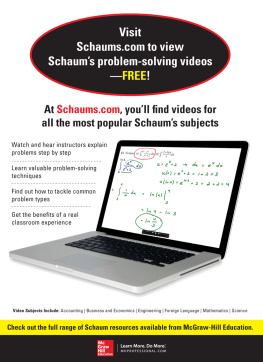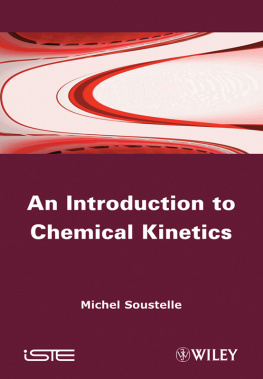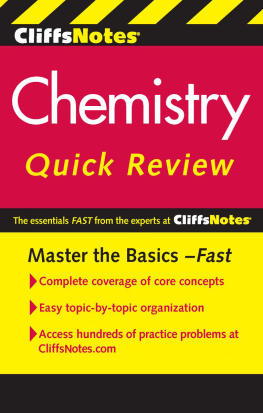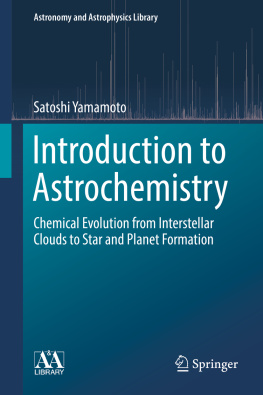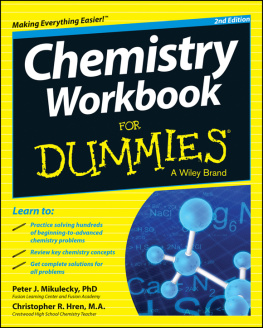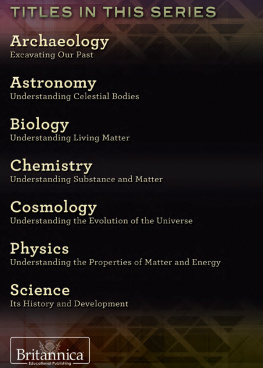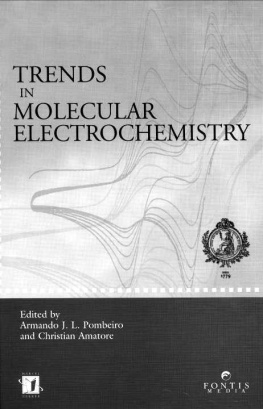JEROME L. ROSENBERG did his graduate work at Columbia University in physical chemistry, receiving his MA in 1944 and his PhD in 1948. His research activities at several institutions resulted in many papers in photosynthesis, general photochemistry, and molecular electronic structure. Formerly Professor of Chemistry, Dean of the Faculty of Arts and Sciences, and Vice Provost at the University of Pittsburgh, he is now Research Integrity Officer and Professor Emeritus of Biological Sciences there. Dr. Rosenberg has been associated with the preparation of Schaums Outline of College Chemistry since the third edition, published in 1949.
LAWRENCE M. EPSTEIN started his career as a chemical engineer, then earned his MS in 1952 and PhD in 1955 from Polytechnic University in the field of physical chemistry. He did research in the fields of radiation chemistry and in Mssbauer effect spectroscopy at Westinghouse Research Laboratories, and then served as Associate Professor and supervisor of the General Chemistry program at the University of Pittsburgh until he retired in 1986.
PETER J. KRIEGER received his BSE (University of Florida) in 1964, his MEd (Florida Atlantic University) in 1969, and his EdD (Florida Atlantic University) in 1976. He began his teaching career in 1964 and has taught all levels from middle school to graduate school in areas including chemistry, biology, and math. He held the position of Department Chairperson for Chemistry and Physics at Palm Beach Community College, Lake Worth, until recently and is the Chairperson for the Chemistry Cluster, the organization of college-wide chemistry personnel. Dr. Krieger has been involved in a number of writing projects relating to chemistry for preprofessional students and for those students headed toward the allied health professions.
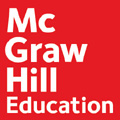
Copyright 2013 by McGraw-Hill Education. All rights reserved. Except as permitted under the United States Copyright Act of 1976, no part of this publication may be reproduced or distributed in any form or by any means, or stored in a database or retrieval system, without the prior written permission of the publisher.
ISBN: 978-0-07-181083-8
MHID: 0-07-181083-8
The material in this eBook also appears in the print version of this title: ISBN: 978-0-07-181082-1, MHID: 0-07-181082-X.
eBook conversion by codeMantra
Version 2.0
All trademarks are trademarks of their respective owners. Rather than put a trademark symbol after every occurrence of a trademarked name, we use names in an editorial fashion only, and to the benefit of the trademark owner, with no intention of infringement of the trademark. Where such designations appear in this book, they have been printed with initial caps.
McGraw-Hill Education eBooks are available at special quantity discounts to use as premiums and sales promotions, or for use in corporate training programs. To contact a representative please e-mail us at bulksales@mheducation.com.
Trademarks: McGraw-Hill Education, the McGraw-Hill Education logo, Schaums and related trade dress are trademarks or registered trademarks of McGraw-Hill Education and/or its affiliates in the United States and other countries and may not be used without written permission. All other trademarks are the property of their respective owners. McGraw-Hill Education is not associated with any product or vendor mentioned in this book.
TERMS OF USE
This is a copyrighted work and McGraw-Hill Education and its licensors reserve all rights in and to the work. Use of this work is subject to these terms. Except as permitted under the Copyright Act of 1976 and the right to store and retrieve one copy of the work, you may not decompile, disassemble, reverse engineer, reproduce, modify, create derivative works based upon, transmit, distribute, disseminate, sell, publish or sublicense the work or any part of it without McGraw-Hill Educations prior consent. You may use the work for your own noncommercial and personal use; any other use of the work is strictly prohibited. Your right to use the work may be terminated if you fail to comply with these terms.
THE WORK IS PROVIDED AS IS. McGRAW-HILL EDUCATION AND ITS LICENSORS MAKE NO GUARANTEES OR WARRANTIES AS TO THE ACCURACY, ADEQUACY OR COMPLETENESS OF OR RESULTS TO BE OBTAINED FROM USING THE WORK, INCLUDING ANY INFORMATION THAT CAN BE ACCESSED THROUGH THE WORK VIA HYPERLINK OR OTHERWISE, AND EXPRESSLY DISCLAIM ANY WARRANTY, EXPRESS OR IMPLIED, INCLUDING BUT NOT LIMITED TO IMPLIED WARRANTIES OF MERCHANTABILITY OR FITNESS FOR A PARTICULAR PURPOSE. McGraw-Hill Education and its licensors do not warrant or guarantee that the functions contained in the work will meet your requirements or that its operation will be uninterrupted or error free. Neither McGraw-Hill Education nor its licensors shall be liable to you or anyone else for any inaccuracy, error or omission, regardless of cause, in the work or for any damages resulting therefrom. McGraw-Hill Education has no responsibility for the content of any information accessed through the work. Under no circumstances shall McGraw-Hill Education and/or its licensors be liable for any indirect, incidental, special, punitive, consequential or similar damages that result from the use of or inability to use the work, even if any of them has been advised of the possibility of such damages. This limitation of liability shall apply to any claim or cause whatsoever whether such claim or cause arises in contract, tort or otherwise.
PREFACE
This book is designed to help the student of college chemistry by summarizing the chemical principles of each topic and relating the solution of quantitative problems to those fundamentals. Although the book is not intended to replace a textbook, its solved problems, with complete and detailed solutions, do cover most of the subject matter of a first course in college chemistry. The student is referred to one of the many standard General Chemistry textbooks for such matters as full treatment of nomenclature, descriptive chemistry of the elements, and more extensive exposition and illustration of principles. Both the solved and the supplementary problems are arranged to allow a progression in difficulty within each topic.
Several important features have been introduced into the sixth edition, notably the kinetic theory of gases, a more formal treatment of thermochemistry, a modern treatment of atomic properties and chemical bonding, and a chapter on chemical kinetics.
In the seventh edition the early chapters were revised to conform more closely to the methods used in current textbooks to introduce calculational skills to the beginning student. Some changes in notation were made, and the usage of SI units was expanded. An attempt was made to increase the variety of stoichiometry problems, especially in the chapters on gases and solutions, while eliminating some of the very complex problems that arise in gaseous and aqueous equilibria. In the treatment of chemical bonding the subject of molecular orbitals was de-emphasized in favor of VSEPR theory. A new chapter on Organic Chemistry and Biochemistry was added, conforming to the trend in current texts.
In the eighth edition we carefully conformed to the language and style of the currently most-used textbooks, for example, using the term molar mass broadly, and eliminating molecular weight and the like. At least 15% of the problems in each chapter are new, and some old ones were dropped, so that the problems better reflect the practical situations of the laboratory, industry, and the environment. The use of SI units has been expanded further, but liter and atmosphere are retained where appropriate.

